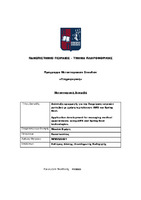Ανάπτυξη εφαρμογής για την διαχείριση ιατρικών ραντεβού με χρήση τεχνολογιών AWS και Spring Boot
Application development for managing medical appointments using AWS and Spring Boot technologies

Προβολή/
Λέξεις κλειδιά
REST API architecture ; Object-Relational Mapping (ORM) ; H2 (in-memory database) ; Thymeleaf ; Relational database service (Aurora) ; RDS (Relational Database Service) ; Amazon Web Services (AWS) ; ECS (Elastic Container Service) ; ECR (Elastic Container Registry) ; Docker container management ; Spring Boot ; AWS ; ECR ; ECS ; Docker ; REST ; APIΠερίληψη
Η διατριβή αυτή αποτελεί μια μελέτη που επικεντρώνεται στον σχεδιασμό, στην ανάπτυξη και στην υλοποίηση μιας εφαρμογής για την ψηφιακή διαχείριση ιατρικών ραντεβού. Η εφαρμογή αυτή προσφέρει μια σύγχρονη λύση για τη βελτίωση της διαχείρισης των ραντεβού, την ενίσχυση της επικοινωνίας μεταξύ ιατρών και ασθενών, και την ασφαλή αποθήκευση των ιατρικών δεδομένων.
Η διαδικασία σχεδιασμού της εφαρμογής περιλαμβάνει τον καθορισμό των, λειτουργικών και μη λειτουργικών της, απαιτήσεων. Η ανάπτυξη και υλοποίηση της πραγματοποιήθηκαν με τη χρήση διαφορετικών τεχνολογιών που εξασφαλίζουν την αποδοτικότητάς της.
Όσον αφορά το backend της εφαρμογής, ο κώδικας υλοποιήθηκε στη γλώσσα προγραμματισμού Java με τεχνολογίες του Spring (Spring Boot). Η εφαρμογή εκτελείται στις υπηρεσίες της Amazon Web Services(AWS) παρέχοντας ένα αξιόπιστο και επεκτάσιμο περιβάλλον για την λειτουργία της. Συγκριμένα οι υπηρεσίες ECS (Elastic Container Service) και ECR (Elastic Container Registry) συμπληρώνουν την τεχνολογική υποδομή που επιτρέπει την απρόσκοπτη λειτουργία της εφαρμογής στο περιβάλλον της AWS και επιλέχθηκαν ως υπηρεσίες διαχείρισης των Docker containers για τον έλεγχο, την κλιμάκωση και την αποθήκευση της εφαρμογής. Η πλήρως διαχειριζόμενη υπηρεσία βάσης δεδομένων σχεσιακού τύπου, με το όνομα Aurora της AWS, γνωστή και ως RDS (Relational Database Service), επιλέχθηκε για την αποθήκευση και την ανάκτηση των δεδομένων με αποτελεσματικότητα και ασφάλεια. Πρόσθετα χρησιμοποιήθηκε η Η2 ως βάση δεδομένων μνήμης για τη διατήρηση των δεδομένων κατά την διάρκεια της ανάπτυξης και δοκιμής της εφαρμογής.
Όσον αφορά το frontend της εφαρμογής, χρησιμοποιήθηκαν τα εργαλεία Thymeleaf (server-side rendering), JavaScript, CSS και HTML έτσι ώστε να μπορούν οι χρήστες να επικοινωνούν και να οργανώνουν τις ιατρικές συναντήσεις με έναν εύχρηστο και φιλικό προς τον χρήστη τρόπο.
Τέλος χρησιμοποιήθηκε η αρχιτεκτονική REST API για την διασύνδεση της εφαρμογής με άλλα συστήματα και η τεχνική ORM (Object-Relational Mapping) για τη διαχείριση και την αλληλεπίδραση με τις βάσεις δεδομένων.


